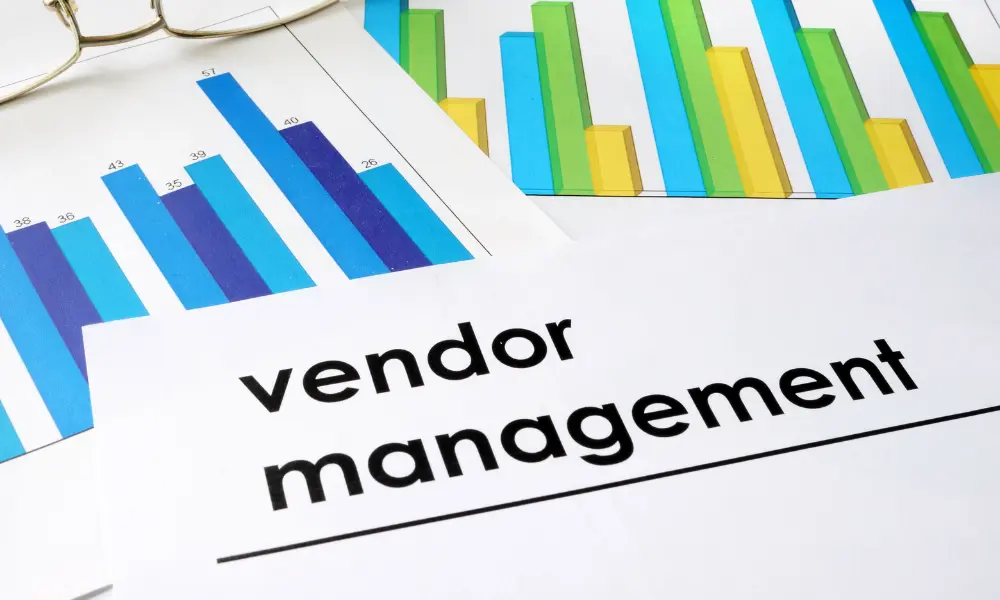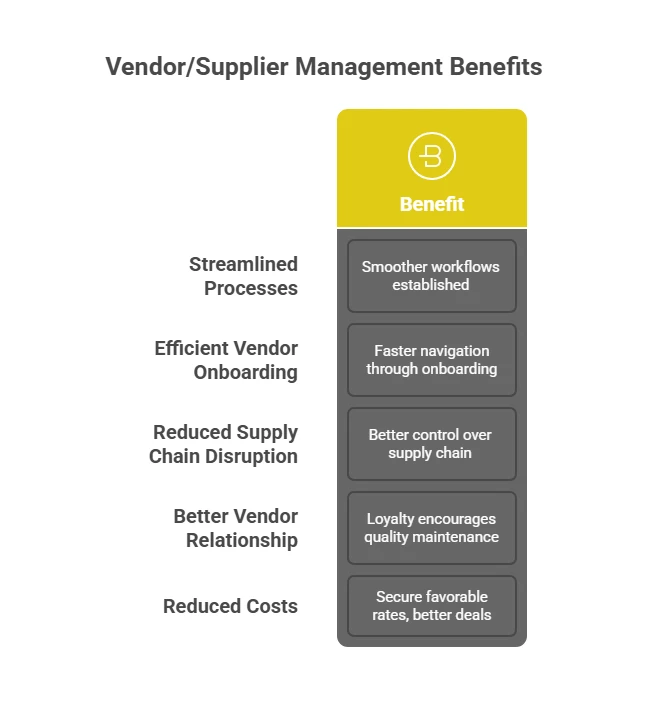
Organizations and companies have various vendors or suppliers who help them to acquire certain parts or products. The process of communication and managing them is popular as vendor management. It has another name-supplier management as it plays a key role in selecting the right vendor for a particular business need.
Additionally, companies also use supplier management to achieve business goals. These include harnessing opportunities for cost savings, as well as taking steps to speed up the onboarding process.
Vendors need effective management to reduce the risk of supply chain disruption and ensure the goods and services provided reach on time. They also ensure that those services are up to the expected standard.
Beyond this, an effective supplier management process can help companies build stronger relationships with their vendors. This, in turn, leads to opportunities to negotiate better rates.
4 Strategies to Implement Vendor Relationship Management
Businesses may have some processes to manage their vendors, but there always is room for improvement. So, here are vendor management strategies. Many procurement leaders around the world use these strategies to optimise vendor spending and improve vendor performance:
1. Risk Management
The importance of vendor management is incomplete without having proper risk management plans in place. Vendor risk management is the process of identifying, assessing and mitigating risk in an organisation’s supply chain.
Best supplier risk management practices monitor vendors actively. Not only that, they also have a contingency plan in place to address every type of risk (strategy, implementation, and performance).
With the pandemic, there is an increased risk in supplier management. A great way to deal with it is to automate your procurement process. This allows procurement teams to focus on strategic tasks instead of routine processes. Elimination of eros happens to a large degree; there is improvement of efficiency and decision-making becomes easier with all the information available easily and clearly.
2. Spend Visibility
Transparency is very important in Vendor information management. Without spend visibility, the hidden costs will go up causing more losses than profits in the chain of business. When you have transparent vendor spending management, it will eliminate hidden costs and indirect spending.
However, when you track the amount spent on each vendor, it can become a time-intensive task. By implementing an automated procurement system, organisations can inject transparency into the procure-to-pay process.
3. Vendor Segmentation
Vendor segmentation is the process of mapping suppliers against profitability and exploring risks. Small and medium businesses with a small supplier base prefer to use simple processes and working models.
Another model is the Deloitte priority model which classifies vendors into three groups: strategic, important and transactional. This classification happens on the basis of business criticality. The Kraljic Matrix maps suppliers into four groups based on two key dimensions: risk and profitability.
4. Vendor Collaboration
When it comes to vendor management, according to a Global CPO survey, 23% of CPOs are focusing on supplier collaboration activities. Fruitful vendor collaborations can not only fortify the buyer-vendor relationship but also deliver tangible benefits (value and cost savings) for both parties.
Although emails and messengers enable real-time communication, they are not the most efficient tools for the job. Cloud-based digital vendor management tools help organisations create a supplier network through enhanced visibility and collaboration.
The procurement management process of measuring and analysing vendor performances helps organisations save money, mitigate risk and drive more value out of the contract.
The cornerstone of this approach lies in establishing a centralised data repository housing all pertinent vendor information. Companies employ a range of tools, spanning from traditional paper forms to spreadsheets and specialised supplier management solutions, to organise and oversee their vendor data.
Stages Involved in Procurement Management
The procurement management life cycle can be divided into five major steps:
Step 1: Vendor Qualification
The initial stage of procurement management involves assessing whether a vendor possesses the expertise and capability required to meet the business needs.
Vendor qualification comprises two types: pre-qualification, conducted for potential vendors, and re-qualification, assessing active vendors’ performance.
Step 2: Vendor Onboarding
Approved vendors are then brought on board into the organisation’s database. This phase entails collecting, recording, and storing all pertinent vendor information in a centralised database.
Step 3: Ordering and Delivery
Typically, either a purchase order or a contract initiates the ordering process. Specifications are clearly outlined in terms of reference (TOR) or statement of work (SOW). Upon fulfilment of the order, received goods/services undergo a quality check, and evaluation occurs.
Step 4: Vendor Payment
Following receipt of goods/services, the buyer matches the invoice with the related purchase order.
If all appears correct, the invoice is approved and sent to finance for payment processing.
Step 5: Vendor Offboarding
Upon contract expiration or termination of a long-term vendor relationship, it is crucial to remove the vendor from finance and administrative records. A supply chain cannot be successful without the smooth functioning of the vendors. So, here are a few reasons why vendors and managing them is extremely important.

Importance of Vendor Management (Supplier Management)
1. Catch up with Market Trends:
Inform your vendors about an ascending demand in the market. Subsequently, you can also advise them to maintain their inventory to satiate the soaring need in the marketplace,
2. Leverage the Opportunity to Improve:
Strategic meetings help vendors to improve consistently. It allows them to learn from other vendors. At the same time, you can also learn from your vendors. For instance, you can analyse their challenges. Through it, you can provide appropriate solutions or tweak processes that suit their needs.
3. Build Long-Term Relationships:
For a long-term association with vendors, it is essential to ensure that they are accomplishing their business goals. To that effect, supplier management assists them in realising their goals by measuring their performance and giving relevant inputs to increase their sales.
4. Provide Better Quality of Products:
The goal of supply management is to provide a standard quality of products and services within a stipulated time and minimal cost. A proper supplier management process helps to ensure that they always meet product quality and customer expectations.
All these points clearly sum up why supplier management is important for the froth of your company. However, setting up the process is just one piece of the puzzle. Executing it properly is an entirely different effort.
With that let’s briefly see the advantages of the vendor management system.
5 Benefits of Vendor/Supplier Management
Here is the full list of perks coming with a proper supplier management strategy:
1. Streamlined Processes
When the responsibilities of both a buyer and vendor are outlined, it is easier to establish smoother workflows. Both parties can manage delivery, compliance and payments to a predefined scenario. This makes it easier to guarantee predictable outcomes and an overall more effective procure-to-pay process.
2. More Efficient Vendor Onboarding
Onboarding new vendors and getting them to speed up might take a lot of time and resources. However, with a supplier management system, new vendors can try a tried and tested path that allows them to navigate through the onboarding process faster.
3. Reduced Risk of Disruption to Supply Chain
This type of management gives you better control over your supply chain. This eliminates any risk of disruptions. Having a handle on vendor relationships allows you to obtain critical vendor information promptly and oversee possible issues.
4. Better Relationship with Vendors
No matter how much you automate or rely on AI processes, you cannot eliminate the human factor from vendor relationships. Effective supplier management strategies require loyalty and encourage vendors to maintain the quality of the provided products and services.
5. Reduced Costs with More Efficiency and Better Vendor Rates
Thanks to robust vendor relationships, you can secure favourable rates and negotiate advantageous deals for your company. Additionally, by understanding your supply chain, you can uncover hidden costs and enhance control over your expenses.

Conclusion
Strong vendor management is no longer optional—it’s a strategic necessity. By selecting the right suppliers, maintaining transparent communication, and consistently evaluating performance, businesses can drive cost-efficiency and reduce supply chain risks.
With a reliable vendor management system, companies benefit from streamlined onboarding, enhanced vendor collaboration, and reduced operational disruptions. These improvements lead to better service quality, stronger supplier relationships, and long-term business growth.
Ultimately, fostering meaningful collaboration with vendors leads to significant cost savings and improved operational efficiency. To ensure your supply chain operates seamlessly and without disruption, connect with the experts at QodeNext today.
FAQs: Vendor Management – Process, Meaning, Definition, and More
1. What is the vendor management meaning?
Vendor management, as the name suggests, is the process that organizations use to manage their vendors or suppliers. Also known as supplier management, it plays a key role in selecting the right vendor for a particular business need.
2. What are the four stages of vendor management?
The four stages are selection, contract negotiation, relationship management, and performance evaluation, involving choosing vendors, negotiating contracts, maintaining relationships, and assessing vendor performance.
3. What is the role of a vendor manager?
A vendor manager establishes and monitors intricate performance metrics as they consider factors like goods or services, timeliness of delivery and cost-effectiveness. They ensure that the company receives optimal value for money. Additionally, they ensure that the vendors remain accountable for maintaining high standards.
4. Why is vendor management important in supply chain management?
Vendor management ensures consistent quality, timely deliveries, cost control, and risk mitigation—making it critical for a reliable supply chain.
5. What are vendor management tools?
Vendor management tools are digital platforms or software that help businesses manage vendor data, track performance, automate onboarding, and ensure compliance.
6. How does vendor management reduce costs?
It helps identify cost-saving opportunities through better rate negotiation, eliminating redundant vendors, optimizing order volumes, and improving delivery timelines.
7. What is a vendor scorecard?
A vendor scorecard is a performance measurement tool that evaluates suppliers based on metrics like delivery time, product quality, pricing, and responsiveness.
8. What are the risks of poor vendor management?
Poor vendor management can lead to supply chain disruptions, quality issues, missed deadlines, increased costs, and reputational damage.
9. Can small businesses benefit from vendor management?
Absolutely. Vendor management helps small businesses build reliable supplier networks, secure better prices, and reduce administrative burdens.
10. What’s the difference between procurement and vendor management
Procurement focuses on sourcing and purchasing goods or services, while vendor management involves overseeing vendor relationships and performance long-term.







